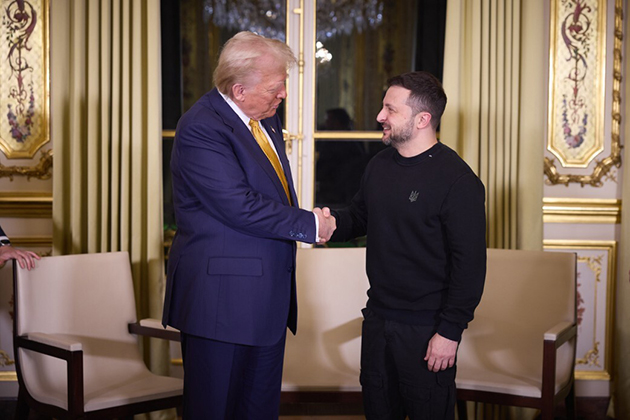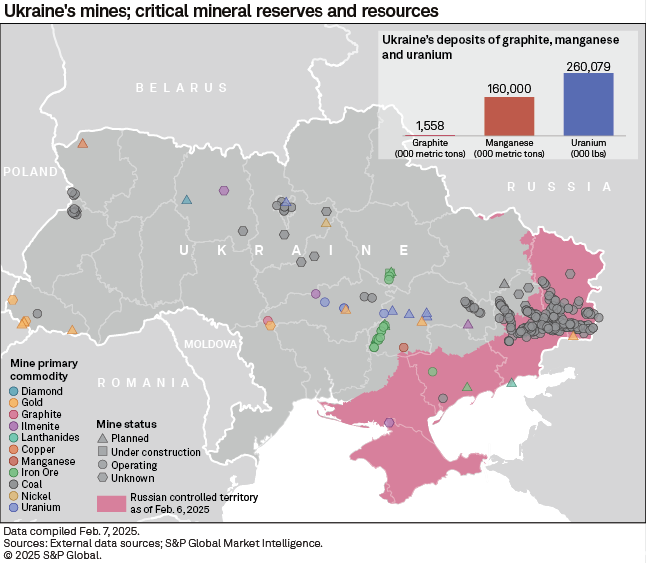S&P Global Offerings
Featured Topics
Featured Products
Events
S&P Global Offerings
Featured Topics
Featured Products
Events
S&P Global Offerings
Featured Topics
Featured Products
Events
Banking & Capital Markets
Economy & Finance
Energy Transition & Sustainability
Technology & Innovation
Podcasts & Newsletters
Banking & Capital Markets
Economy & Finance
Energy Transition & Sustainability
Technology & Innovation
Podcasts & Newsletters
S&P Global Offerings
Featured Topics
Featured Products
Events
13 Feb, 2025
By Liubov Georges

| Ukrainian President Volodymyr Zelenskyy and US President Donald Trump met Dec.7, 2024, in France Source: Ukrainian Presidency/Anadolu via Getty Images. |
Ukraine is relying on a Soviet-era assessment of difficult-to-access rare earths deposits, according to industry experts and a geological record obtained by S&P Global Commodity Insights, as the country prepares to offer minerals to the US in exchange for military assistance.
US Vice President JD Vance will meet with Ukrainian President Volodymyr Zelenskyy on Feb. 14 at the Munich Security Conference to discuss an end to a three-year war that began when Russia invaded Ukraine. But Zelenskyy's rare earths offer is based on exploration activities that took place largely between the 1960s and 1980s, when the Soviet state was actively mapping the area, industry experts said.
The deposits would be difficult to develop. Some are stuck behind battle lines or, in the case of the geological record for one of the sites, require advanced processing technology and a stable energy grid to extract. And the valuation of the deposits is based on decades-old data: No sources contacted by Commodity Insights were aware of any commercial exploration or assessment of those deposits in the post-Soviet period.
The Ukrainian Geological Survey is the government agency responsible for mineral development.

Deal or no deal
US President Donald Trump said Ukraine must guarantee its continued military aid from the US with "rare earths and other things," adding Feb. 10 that he wants $500 billion worth of rare earths. Zelenskyy seems ready to make a deal. The Ukrainian president described the country's rare earths deposits as "priceless" during a Feb. 7 interview with Reuters, adding that "Americans helped the most, and therefore the Americans should earn the most" in rebuilding Ukraine.
Out of six rare earth deposits in Ukraine, only the Novopoltavske field in the Zaporizhzhia region has proven reserves with the license open for nomination. The large phosphate and rare earth deposit requires a $300 million investment, according to "Ukraine: Mining Investment Opportunities," a report by the Ukrainian Geological Survey and the Ministry of Environmental Protection and Natural Resources of Ukraine.
The complex was first discovered in 1970 by Soviet geologists and was tested during preliminary and detailed exploration from 1978 to 1991, according to a geological record from the State Geologic and Subsoil Survey of Ukraine. The Novopoltavske deposit was found to contain a combination of phosphate ores, rare earth compounds and niobium ores, among other elements, under "relatively difficult" hydrogeological and mining conditions.
"On the rare earth elements classification, it's the most complex of compounds to process and recover. Only China, the US and Russia have proven to commercially recover these,"
The rare earths comprise the 15 elements forming the lanthanide series as well as two transition metals, scandium and yttrium.
Costly to extract
Exploration efforts were abandoned after a 13-year assessment process, and no attempts have been made to develop the Novopoltavske deposit since the breakup of the Soviet Union in 1991, according to experts.
Ukraine's deposits of rare earth elements might not be profitable to extract.
"To my knowledge, there are no economically viable rare earth deposits in Ukraine," said Tony Mariano, an independent geologist consultant with expertise in rare earths exploration. "I have evaluated clay deposits in Ukraine thought to have potential for rare earths but found them not to be viable. This doesn't mean there aren't any, only that further exploration and evaluation needs to be done."
Other known rare earth deposits in Ukraine include the Azovske and Mazurivske deposits in the Donetsk region. Both deposits have fallen under the territorial control of the Russian Federation, based on S&P Global Market Intelligence's latest maps of Russian advances in Ukraine.
Russia's invasion in February 2022 stymied any recent attempts to further explore the region, and no private entity assessed the deposits during earlier, more peaceful times.
Additionally, information about deposits of some rare earth elements such as scandium is classified under the Resolution of the State Security Service of Ukraine from Dec. 23, 2020, due to the war.
"This secrecy is absurd, since the main deposits were discovered before 1991, and geological reports were transmitted to Moscow. So, Russia knows about our resources and reserves as much as we do," Hanna Liventseva, former chair for the Ukrainian Association of Geologists, said in an email.
Ukraine produces iron ore, coal and uranium, but Market Intelligence data does not show any reserves of rare earths, and Ukraine is not listed on the US Geological Survey's list of countries with meaningful rare earths reserves.
"I am not aware of any significant rare earth assets or reserves in Ukraine. This is just another breathless fantasy that we will magically solve our critical mineral constraints through a country at war. The closest analogy for me is the very similar hyperbole about the trillions of dollars of minerals sitting under Afghanistan," said Morgan Bazilian, director of the Payne Institute for Public Policy at the Colorado School of Mines.
"Just like the latest hyperbole, I imagine it too will fade away once people realize that mining and processing minerals is difficult, requires a great deal of infrastructure, is time-consuming and often not economically viable, and takes significant expertise," Bazilian added.
